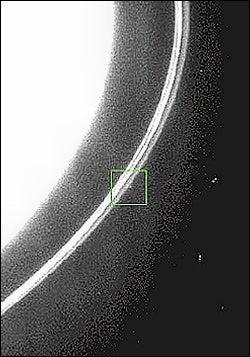Sometimes it pays to be looking in just the right place. Ask Carl Murray, Cassini imaging team member at Queen Mary, University of London. Murray was examining images taken June 21, 2004, a few days before the Cassini spacecraft arrived at Saturn. “I noticed this barely detectable object skirting the outer part of the F ring. It was an incredible privilege to be the first person to spot it,” he said.
Meanwhile, at the Space Science Institute in Boulder, Colorado, planetary scientist Joseph Spitale was searching for additional images to refine the orbit of S/2004 S3. “I found that about 5 hours after first being sighted, it seemed to be orbiting interior to the F ring,” said Spitale. “If this is the same object then it has an orbit that crosses the F ring, which makes it a strange object.” The object seen by Spitale has been designated S/2004 S4. That designation will change if astronomers discover the two sightings are the same object. Presently, Saturn has 33 confirmed moons.
As if finding a new moon around a distant world wasn’t enough, Murray also detected a new ring — S/2004 1R — that has been associated with Saturn’s moon Atlas. “It was while studying the F ring in these images that I discovered the faint ring of material,” said Murray. “My immediate hunch was that it might be associated with the orbit of one of Saturn’s moons, and after some calculation I identified Atlas as the prime suspect.”
S/2004 1R is nearly as far from Saturn as the new moon, lying in the orbit of Atlas, 85,500 miles (138,000 km) from the planet’s center. The ring is 190 miles (300 km) wide.










